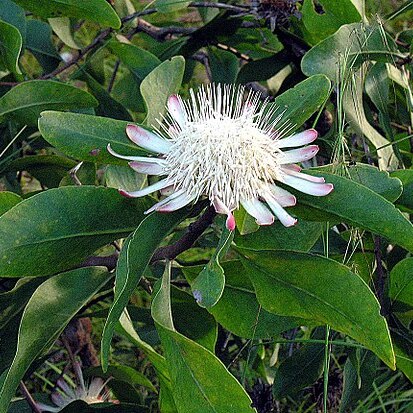Large bush to small tree 2-8(-10) m. high, or rarely a shrub 1-2 m.. Young branches densely pubescent when young, but glabrescent, brown, flaking slowly to expose a rusty cortex.. Leaves narrowly oblanceolate to linear-oblanceolate, tapering from above the middle to a narrowly rounded or sometimes cuneate base, 10-18(-20) × (1.4-) 1.7-2.8(-3.6) cm., (4.5-)5-9(-10) times as long as broad, subacute to narrowly rounded at the apex, appressed-pubescent when young but rapidly glabrescent and nearly always glabrous at maturity, sometimes somewhat glaucous.. Heads 6-11 (-13) cm. in diameter excluding exserted styles, sometimes recorded as having an unpleasant smell.. Middle bracts (1.4-) 2-3(-3.3) × (1.2-)1.5-2(-2.3) cm., rounded at apex, appressed tomentose all over or the margins sometimes glabrous, the hairs usually silver-or grey-brown (often grey towards the centre and brown towards the margin), glabrous parts greenish to reddish brown; inner bracts linear-oblong to linear-spathulate, 3.5-5 × (0.5-)0.8-l(-1.3) cm., shorter than the flowers, appressed tomentose like the middle bracts or more often glabrous along the margins, usually greenish white.. Flowers (3.5-)4.5-6(-6.5) cm., creamy white or occasionally with a pinkish tip.. Perianth-base glabrous to brown-villous outside, glabrous or occasionally with short whitish pubescence at junction with claw inside; claw thinly brown-villous outside; limb (11-) 12-21 (-25) mm., densely brown-villous.
Middle bracts (1.4)2–3(3.3) × (1.2)1.5–2(2.3) cm, rounded, appressed-tomentose all over or the margins sometimes glabrous, the hairs usually silver-or grey-brown (often grey towards the centre and brown towards margins), glabrous parts greenish to reddish-brown; inner bracts 3.5–5 × (0.5)0.8–1(1.3) cm, linear-oblong to linear-spathulate, shorter than the flowers, appressed tomentose like the middle bracts or more often glabrous along the margins, usually greenish-white.
Leaves 10–18(20) × (1.4)1.7–2.8(3.6) cm, (4.5)4–9(10) times as long as broad, narrowly oblanceolate to linear-oblanceolate, tapering from above the middle to a narrowly rounded or sometimes cuneate base, subacute to narrowly rounded at the apex, appressed-pubescent when young but rapidly glabrescent and nearly always glabrous at maturity, sometimes somewhat glaucous.
A stout shrub. It has spreading branches. It can be 5 m high. The leaves are 15 cm long by 2 cm wide. They are leathery. They taper to the base. The heads are rounded at the base. They open widely. They are 5 cm long and 15 cm wide. The bracts are overlapping. They are broad and silky.
Perianth base glabrous to brown villous outside, glabrous or occasionally with short whitish pubescence at the junction with claw inside; claw thinly brown villous outside; limb (11)12–20(25) mm long, densely brown villous.
Erect, spreading shrub or small, gnarled tree, up to 3 m tall. Involucral bracts covered with fine, densely ad-pressed, silvery, sericeous indumentum. Perianth densely whitish pubescent.
A large bush to tree 2–8(10) m high, or rarely a shrub 1–2 m; young branches densely pubescent when young but glabrescent, brown, flaking slowly to expose a rusty-brown cortex.
Heads 6–11(13) cm diameter excluding exserted styles, sometimes recorded as having an unpleasant smell.
Flowers (3.5)4.5–6(6.5) cm long, creamy-white, occasionally with a pinkish tip.


